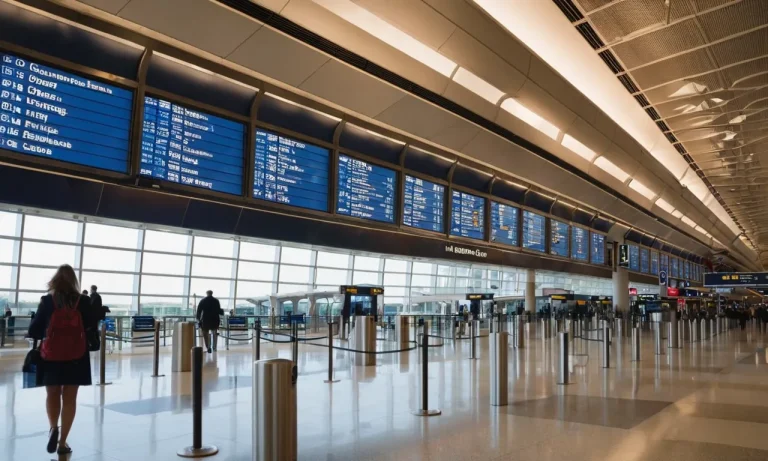For budget-conscious travelers, the quest for the cheapest flights can feel like a perpetual game of chess against airline pricing.
One of the most enduring rumors in this game? The supposed magic of **Tuesday** as the prime day to snag deals.
But is there any truth to this whispered wisdom, or is it simply a flight of fancy?
If you’re short on time, buckle up: While Tuesday may offer occasional and significant price dips, it’s not a guaranteed goldmine.
This article delves deeper, exploring the complex factors that influence airfare, debunking myths, and equipping you with actionable tips to find the best deals, regardless of the day of the week.
Prepare to embark on a journey through the skies of flight pricing, covering:
Myth or Magic: Demystifying the Tuesday Price Drop
Where did the Tuesday myth originate?
The idea that Tuesday is the best day to buy airline tickets took off largely thanks to the advent of airfare prediction tools in the early 2000s.
Sites like Farecast (later acquired by Microsoft’s Bing Travel) analyzed historical pricing data and noticed a pattern – prices tended to dip on Tuesdays more often than other days.
This led to the catchy and sticky myth that Tuesday is a magic day for flight deals.
Beyond the day: Understanding the real drivers of airfare fluctuations
Rather than pins hopes on a single magic day, travelers are better served understanding the key factors that influence flight costs and monitoring them closely to snag deals.
- Time to departure – Prices typically peak 1-3 months out and decline in the last 2-4 weeks.
- Day of the week – Departing on less popular travel days like Tuesday-Thursday can save up to 15%.
- Competition – More carriers on a route leads to better pricing.
- Holidays/events – Prices rise for peak seasons like Christmas; fall for low demand times.
- Sales/mistakes – Keep an eye out for airlines’ fare sales and mistakenly published cheap fares.
While the Tuesday fare drop myth has largely been debunked, monitoring airfare trends and patterns is still worthwhile. Savvy travelers just need to focus on the bigger picture – not a single magic day.
Beyond Tuesday: Secrets to Scoring Flight Deals Any Day
Timing is everything: Understanding peak seasons and fare fluctuations
Scoring low airfares is often about timing. Peak travel seasons like summer and holidays are generally the most expensive times to fly.
Being flexible with your travel dates and flying during shoulder seasons can lead to big savings.
Keep an eye out for fare sales, which airlines often run between peak seasons. Sign up for airline emails and follow them on social media to be notified of deals.
Fares also fluctuate day to day and even hour to hour.
Prices are driven by demand. Less desirable departure times like early mornings and red-eye flights are often cheaper. Be sure to search for fares multiple times before booking.
Flexibility is key: Mastering the art of searching for alternative dates and airports
Having some wiggle room with your travel dates opens up more possibilities for deals. Consider flying a day before or after your original departure dates.
Searching a range of dates rather than one specific date increases your chances of finding a fare drop.
Expanding your airport options can also lead to big savings. Search fares from all airports within driving distance, as prices can vary greatly by airport.
Alternate airports may have lower demand on certain routes, leading to cheaper fares.
Be a savvy shopper: Utilizing incognito mode, price trackers, and error fares
Browsing for fares in incognito or private mode prevents cookies from tracking your search history and potentially raising prices.
Regularly clearing your browser cookies/cache has a similar effect.
Embrace the power of loyalty programs: Reap the rewards of frequent flyer programs and credit card benefits
Loyalty pays when it comes to flight deals. Frequent flyer programs offer perks like fee waivers, upgrades, and access to special fares.
Many cards like the Chase Sapphire Reserve offer bonus points on travel purchases which can be used to book award flights.
Co-branded airline credit cards provide other benefits like free checked bags, priority boarding, and inflight discounts that add up, potentially justifying the annual fee.
Weekdays vs. Weekends: Unveiling the Price Patterns
Weekday warriors: Are midweek flights truly cheaper?
It’s a common belief that booking flights midweek leads to the lowest fares, but is this assumption valid?
Research indicates there is some truth to cheaper weekday flights, though the savings depend on factors like destination and time of year.
Weekend wanderlust: Why Saturday and Sunday prices might soar
For leisure travelers with flexible schedules, weekends often represent the most convenient time to fly.
With greater demand from tourists, prices for weekend flights may spike above weekday fares on popular routes.
Higher weekend demand isn’t the only factor driving up prices. Reduced airline staffing on weekends could constrain flight options.
Flying on lower-demand days allows airlines to maximize fleet usage without overextending staff.
Exceptions to the rule: Holidays, school breaks, and event disruptions
While the weekday vs. weekend pricing patterns generally hold true, holidays, school breaks, and major events can upend typical fare fluctuations.
Here are some examples of when midweek deals might disappear:
- Thanksgiving and other holiday travel periods when demand spikes
- Spring break for schools and colleges
- Major sporting events like the Super Bowl
- Large conventions and conferences midweek
Savvy travelers aim to book far in advance when they know demand will be high, locking in lower fares before prices jump. Flexibility to shift travel dates around peak periods can also yield big savings.

Tools and Resources: Your Arsenal for Flight Price Mastery
Flight comparison websites: Aggregating deals from multiple airlines
Flight comparison websites like Skyscanner, Kayak, and Google Flights are your best friends when it comes to finding the cheapest flights.
These sites aggregate flight options across hundreds of airlines and online travel agencies, allowing you to quickly see the lowest available fares for your chosen route and dates.
Some useful features to utilize on flight comparison sites include:
- Flexible date search – See price graphs showing the cheapest/most expensive dates to fly.
- “Everywhere” search – Discover surprising destination deals you may not have considered.
- Price alerts – Get notified when prices drop on your preferred route.
By leveraging flight comparison sites, you can easily spot airfare sales and score deals that beat the prices offered on individual airline sites.
Just be sure to then book directly on the airline’s website once you’ve identified the best deal.
Fare calendars: Visualizing price trends across different dates
One of the best ways to strategically book a cheap flight is to utilize a fare calendar to visualize airfare trends.
Fare calendars, offered on sites like Kayak and Google Flights, display a monthly grid view of prices for different travel dates.
This allows you to easily spot cheap or expensive date ranges at a glance. Some tips for using fare calendars effectively include:
- Check prices 3-4 months before your planned travel for the best deals.
- Be flexible – Shifting your dates by a few days can yield big savings.
- Compare weekend vs. weekday pricing – Fridays and Sundays often have the highest fares.
With some strategic planning using fare calendars, you can determine the optimal time to book for huge savings – sometimes hundreds of dollars less than the average fare.
Email alerts: Setting up notifications for price drops on your desired routes
One of the easiest ways to keep tabs on flight deals is by setting up email price alerts.
Sites like Kayak and Google Flights make it simple to input your preferred airports and travel dates, and get notified if prices drop. Some tips for effectively using price alerts:
- Set broad date ranges – Give the alert a bigger pool of dates to pull cheap fares from.
- Choose your price threshold wisely – Don’t set it too low or you’ll get alerted to every minor blip.
- Create alerts 3-5 months out from travel – This is when the biggest drops tend to happen.
With airfare fluctuating constantly, price alerts eliminate the need to manually check prices every day. And they ensure you’re among the first to know when airfare dips on your chosen flights.
Mobile apps: Taking your deal-hunting on the go
The top flight comparison and airline booking sites all offer intuitive mobile apps that make flight deal-hunting easier than ever. Key features of these apps include:
- Mobile fare calendars – Visualize date-based fare trends on the fly.
- Instant price alerts – Get notifications of price drops as they happen.
- One-touch booking – Secure your chosen flight with just a few taps.
Armed with the apps from Kayak, Google Flights, Skyscanner and your preferred airlines, you’ll have instant access to flight deals whether you’re at home or on the go.
Plus, you can swoop in and book discounted fares in real time before the prices go back up.
Beyond the Bargain: Prioritizing Value over Price
Time is money: Balancing cost with travel convenience
When booking flights, it’s tempting to simply search for the cheapest fare and click buy. But the true cost of travel goes far beyond the base ticket price.
Savvy travelers know that time is money – a “cheap” flight with terrible layovers can end up costing you precious hours of your vacation.
Here are some tips for weighing ticket cost vs overall travel convenience:
- Consider direct flights to avoid lengthy layovers. Yes, they usually cost more, but the time savings may be worth it.
- Compare departure times thoughtfully. An early morning or late night flight saves money but reduces usable vacation time.
- Think about total trip duration. A quicker nonstop could justify a higher fare.
- Research airport logistics. Is it a hub with more flight options or a smaller airport with limited amenities?
The bottom line is that a “cheap” flight can become quite costly if it turns your vacation into an endless travel ordeal.
Analyze both price and convenience to ensure you maximize your time off.
Comfort matters: Considering amenities, layovers, and overall travel experience
Travel comfort goes a long way towards making any trip more enjoyable. When flight shopping, look beyond the ticket price to consider amenities and overall experience.
Key factors to weigh:
- Seat quality – More legroom, recline, width, and pitch justify higher fares for many.
- In-flight entertainment – Movies, TV, and WiFi allow you to pass time pleasantly.
- Food/beverage service – Free snacks and drinks make a big difference on long flights.
- Frequent flyer perks – Extra legroom seats, lounge access, priority boarding.
- Layover experience – Premium lounges, shops, restaurants, and services.
Conclusion
While Tuesday may not be the automatic answer to finding the cheapest flights, understanding the factors that influence pricing empowers you to become a savvy airfare navigator.
By embracing flexibility, utilizing smart tools, and prioritizing value, you can confidently take off on your next adventure, knowing you’ve secured the best deal, regardless of the day of the week.
[Image of a person booking a flight online with a surprised and excited expression]





